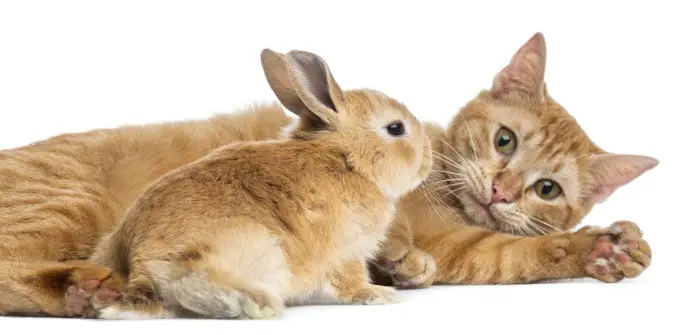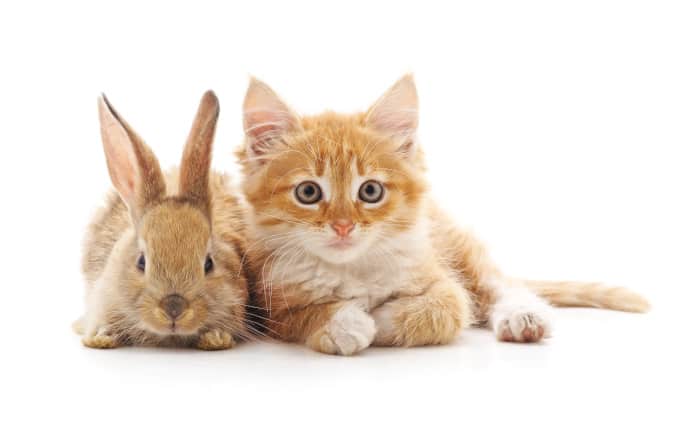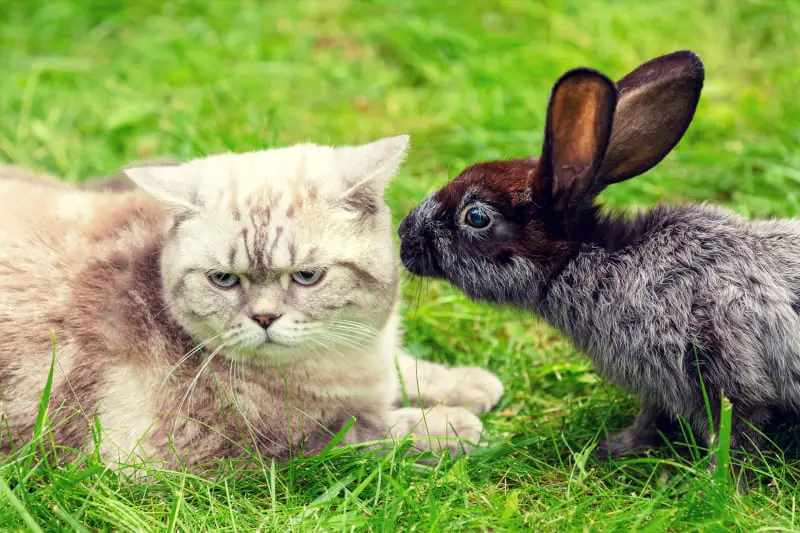We have all at some point listened to stories or witnessed an internet video of a rabbit and a cat who have become friends. For years, dogs, cats, and rabbits have been the pets of choice in many of our homes. For that reason, it should not surprise us when we see animals of different species living together in a friendly way.
Many people are reluctant to believe that this coexistence is successful due to the nature and instinct of each animal. However, with patience, we can manage to shape our pets’ behavior.
Unfortunately, there is no such thing as a magic formula that would be completely effective in ensuring the well-being of each one of them. The healthy coexistence between these species depends on the nature of each individual and the particular circumstances.
Can Rabbits and Cats Get Along?
Cohabitation in animals of different species may seem to be a little difficult, but it is not impossible. Animals of different species can get along very well in your home.
Bunnies and felines can turn out to be old buddies, given that the initial moves towards their coexistence are taken steadily and cautiously.
If you are thinking of hosting these two animals under the same roof, you must take into consideration certain aspects before you make the decision. Here are some tips to make it possible to cohabit between cats and rabbits.
What Are You Facing?
Pet owners know how important it is that each one gets along, especially if they are pets of different species, as is the case of coexistence between rabbits and cats. There is a huge difference between having a peaceful family life, and the constant struggle to prevent the cat from trying to catch the rabbit.
To achieve a healthy coexistence between your pets, you must begin by understanding the nature and characteristics of each one in particular. Several factors can be involved in the interaction of different species, such as whether they are male or female, and whether they are spayed or neutered, among others.
The first thing to keep in mind is that rabbits and cats are very different. In the wild, they’re not friends. Rabbits are prey, and cats are predators. By instinct, rabbits fear predators, as they could pose a threat to their lives.
Therefore, this situation should be addressed with a great deal of persistence and patience.

The Nature of Rabbits
Rabbits, in general, are very sociable and docile animals. They prefer to live in groups and show a social hierarchy. They will also exhibit dominating behavior towards each other. Usually, the ideal companion for a rabbit is another rabbit. Unfortunately, this is not always possible so we must be careful when our rabbits have to live together with other species.
Rabbits are also territorial, especially does. Their instinct leads them to defend their territory against invaders. Male rabbits or bucks are usually less aggressive than does.
We must emphasize that rabbits are animals of prey. They serve as a source of nourishment for other animals. Their instincts have led them to remain alert, cautious, and somewhat fearful at all times.
What About Cats?
Cats are more independent animals, less sociable, and somewhat stubborn. Although many can be quite affectionate, the vast majority tend to possess a rather strong character, as they are feline descendants.
Cats are carnivores and tend to keep their hunting instincts intact. For a cat, the rabbit is a prey.
If you put an adult cat together with a rabbit, especially if it is a small breed, you will most likely have a lot of trouble, since the cat’s instinct is to hunt. Cats are hunting machines in the wild. In such cases, you must take certain precautions if you don’t want the attempt at coexistence to end in tragedy.
How to Achieve A Successful Coexistence?
Now that you know the difference between cats and rabbits, the question that comes to mind is, how do you get them to get along?
The coexistence between rabbits and cats depends a lot on the temper of both animals. If introducing a cat and a rabbit, it is extremely important to be patient and cautious. The socialization between both species should be done little by little.
If your rabbit is shy and fearful, it will have a hard time coping with a cat that is too dominant. However, there are many cases in which the roles are inverted, and it is the rabbits that tend to frighten their feline companions, especially if it is a rabbit that has a great deal of self-esteem.
The Perfect Time to Introduce Your Rabbit to Your Cat
The bond between a rabbit and a cat will be much easier if both animals come home as babies.

Between the first 2 and 3 months, cats go through a period of learning and socialization. Those weeks are the perfect time to relate and get used to living with other cats, other animals, and people. It is precisely during this time that a cat can make friends with a rabbit, since it will not see it as prey, nor will the rabbit see it as a predator.
As for the rabbits, these animals can quickly learn their instinct of conservation, so if you want them to get along with your cat, you will have to adopt them before they are three months old. This way, the preservation and predation instincts will not be aroused. Being both babies, they won’t feel any kind of threat and will become companions for the rest of their lives.
But it is not always possible to take in both animals at the same time.
What to Do When The Cat Is Already An Adult?
Before introducing your rabbit to your adult cat, you should allow time for your rabbit to get used to its new home and environment. Keep in mind that rabbits are sensible creatures, and anything new is likely to cause them stress.
Once the rabbit has become familiar and is comfortable and relaxed in its new home, it is time to introduce it to your cat.
The rabbit must remain in its cage during the first encounters. The rabbit must have enough space to jump so that the cat can get used to its movements. Also, the cage should have some shelter where the rabbit can protect itself in the event of feeling frightened. You should always allow for gradual interaction only through the cage.
You must be patient as this process can take days or weeks until you can see both animals calmly one in the presence of the other.
What’s The Next Step?
When you see that both have become habituated to being together, the next step is to allow direct contact between both pets outside the cage. They should always remain under your supervision.
Allow them to see each other and share some time occasionally. Depending on the level of conduct improvement, you may allow them to share additional time in the same room.
At this phase, you should be aware of any changes in your pets’ behavior, as it may be necessary for you to intervene in any unwanted situation.
What to Do When The Rabbit Is Already An Adult?
No matter how small the cat, the first interaction should be given equally through the cage. This way, they can both smell and get used to each other safely. The interaction between the cat and the rabbit should be progressive. As in the previous case, it can take days or weeks.
Once you think the right time has come, let them get to know each other without the cage. Try to extend coexistence every day a little longer until you notice that they remain relaxed.
However, you should never leave them unattended, and you should always remain alert. Don’t forget that rabbits live in hierarchical societies, so it may also try to attack the cat if it is too small.

Additional Tips
Animals can be unpredictable. Whenever you are going to introduce animals of different species, do so with caution and never leave them unattended. Here are some additional tips that we hope you will find useful in handling the situation.
- You should only intervene if you see any aggressive or threatening attitudes.
- The best way to intervene is to spray the cat with a water gun. Cats are so smart. Don’t let them know that you are spraying them. If they do, they might begin to wait until you are not around to attack the bunny.
- Keep your feline’s claws short throughout the adaptation process.
- Play with them daily and try to pet one and then the other. In this way, their bodies will acquire each other’s scent, and they will end up recognizing each other as family.
- If you need to leave, it is advisable to leave the rabbit in its cage.
- Cats are small animal predators and tend to avoid attacking animals that are the same size or larger. If you want to add a rabbit to your family and you already have an adult cat, you can always consider choosing a large breed rabbit.
Chases can occur not only from cats to rabbits, but also some rabbits are the ones that attack the cats. As we have already mentioned, rabbits are quite hierarchical and territorial. When they feel threatened, their instinct can lead them to attack. In most cases, to avoid this type of situation, you only need to be around for both animals to realize that you are the one who is in charge.
To Conclude
Although it is not always easy for two different species of animals to live under the same roof, it is not impossible. Our success in achieving this coexistence will depend to a great extent on our approach, our patience, and our knowledge.
Nobody else has a better understanding of the temperament of your pets than you. You must be vigilant and intuitive about how willing or empathetic your pet can be to accept a new companionship.
There is always the possibility that this coexistence may not be possible. In such cases, you will have to choose to separate them. Above all, the most important thing is to save the well-being of our pets.


